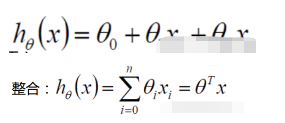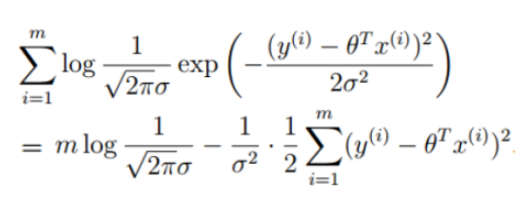您好,登錄后才能下訂單哦!
您好,登錄后才能下訂單哦!
這篇文章主要講解了“python如何實現梯度下降求解邏輯回歸”,文中的講解內容簡單清晰,易于學習與理解,下面請大家跟著小編的思路慢慢深入,一起來研究和學習“python如何實現梯度下降求解邏輯回歸”吧!

似然函數的定義:給定聯合樣本值X下關于(未知)參數
的函數


似然函數:什么樣的參數跟我們的數據組合后恰好是真實值

對數似然:


(誤差的表達式,我們的目的就是使得真實值與預測值之前的誤差最小)

(導數為0取得極值,得到函數的參數)
邏輯回歸是在線性回歸的結果外加一層Sigmoid函數


前提數據服從伯努利分布

對數似然:

引入 轉變為梯度下降任務,邏輯回歸目標函數
轉變為梯度下降任務,邏輯回歸目標函數
我的理解就是求導更新參數,達到一定條件后停止,得到近似最優解
Sigmoid函數
def sigmoid(z): return 1 / (1 + np.exp(-z))
預測函數
def model(X, theta): return sigmoid(np.dot(X, theta.T))
目標函數

def cost(X, y, theta): left = np.multiply(-y, np.log(model(X, theta))) right = np.multiply(1 - y, np.log(1 - model(X, theta))) return np.sum(left - right) / (len(X))
梯度

def gradient(X, y, theta): grad = np.zeros(theta.shape) error = (model(X, theta)- y).ravel() for j in range(len(theta.ravel())): #for each parmeter term = np.multiply(error, X[:,j]) grad[0, j] = np.sum(term) / len(X) return grad
梯度下降停止策略
STOP_ITER = 0 STOP_COST = 1 STOP_GRAD = 2 def stopCriterion(type, value, threshold): # 設定三種不同的停止策略 if type == STOP_ITER: # 設定迭代次數 return value > threshold elif type == STOP_COST: # 根據損失值停止 return abs(value[-1] - value[-2]) < threshold elif type == STOP_GRAD: # 根據梯度變化停止 return np.linalg.norm(value) < threshold
樣本重新洗牌
import numpy.random #洗牌 def shuffleData(data): np.random.shuffle(data) cols = data.shape[1] X = data[:, 0:cols-1] y = data[:, cols-1:] return X, y
梯度下降求解
def descent(data, theta, batchSize, stopType, thresh, alpha): # 梯度下降求解 init_time = time.time() i = 0 # 迭代次數 k = 0 # batch X, y = shuffleData(data) grad = np.zeros(theta.shape) # 計算的梯度 costs = [cost(X, y, theta)] # 損失值 while True: grad = gradient(X[k:k + batchSize], y[k:k + batchSize], theta) k += batchSize # 取batch數量個數據 if k >= n: k = 0 X, y = shuffleData(data) # 重新洗牌 theta = theta - alpha * grad # 參數更新 costs.append(cost(X, y, theta)) # 計算新的損失 i += 1 if stopType == STOP_ITER: value = i elif stopType == STOP_COST: value = costs elif stopType == STOP_GRAD: value = grad if stopCriterion(stopType, value, thresh): break return theta, i - 1, costs, grad, time.time() - init_time
import numpy as np
import pandas as pd
import matplotlib.pyplot as plt
import os
import numpy.random
import time
def sigmoid(z):
return 1 / (1 + np.exp(-z))
def model(X, theta):
return sigmoid(np.dot(X, theta.T))
def cost(X, y, theta):
left = np.multiply(-y, np.log(model(X, theta)))
right = np.multiply(1 - y, np.log(1 - model(X, theta)))
return np.sum(left - right) / (len(X))
def gradient(X, y, theta):
grad = np.zeros(theta.shape)
error = (model(X, theta) - y).ravel()
for j in range(len(theta.ravel())): # for each parmeter
term = np.multiply(error, X[:, j])
grad[0, j] = np.sum(term) / len(X)
return grad
STOP_ITER = 0
STOP_COST = 1
STOP_GRAD = 2
def stopCriterion(type, value, threshold):
# 設定三種不同的停止策略
if type == STOP_ITER: # 設定迭代次數
return value > threshold
elif type == STOP_COST: # 根據損失值停止
return abs(value[-1] - value[-2]) < threshold
elif type == STOP_GRAD: # 根據梯度變化停止
return np.linalg.norm(value) < threshold
# 洗牌
def shuffleData(data):
np.random.shuffle(data)
cols = data.shape[1]
X = data[:, 0:cols - 1]
y = data[:, cols - 1:]
return X, y
def descent(data, theta, batchSize, stopType, thresh, alpha):
# 梯度下降求解
init_time = time.time()
i = 0 # 迭代次數
k = 0 # batch
X, y = shuffleData(data)
grad = np.zeros(theta.shape) # 計算的梯度
costs = [cost(X, y, theta)] # 損失值
while True:
grad = gradient(X[k:k + batchSize], y[k:k + batchSize], theta)
k += batchSize # 取batch數量個數據
if k >= n:
k = 0
X, y = shuffleData(data) # 重新洗牌
theta = theta - alpha * grad # 參數更新
costs.append(cost(X, y, theta)) # 計算新的損失
i += 1
if stopType == STOP_ITER:
value = i
elif stopType == STOP_COST:
value = costs
elif stopType == STOP_GRAD:
value = grad
if stopCriterion(stopType, value, thresh): break
return theta, i - 1, costs, grad, time.time() - init_time
def runExpe(data, theta, batchSize, stopType, thresh, alpha):
# import pdb
# pdb.set_trace()
theta, iter, costs, grad, dur = descent(data, theta, batchSize, stopType, thresh, alpha)
name = "Original" if (data[:, 1] > 2).sum() > 1 else "Scaled"
name += " data - learning rate: {} - ".format(alpha)
if batchSize == n:
strDescType = "Gradient" # 批量梯度下降
elif batchSize == 1:
strDescType = "Stochastic" # 隨機梯度下降
else:
strDescType = "Mini-batch ({})".format(batchSize) # 小批量梯度下降
name += strDescType + " descent - Stop: "
if stopType == STOP_ITER:
strStop = "{} iterations".format(thresh)
elif stopType == STOP_COST:
strStop = "costs change < {}".format(thresh)
else:
strStop = "gradient norm < {}".format(thresh)
name += strStop
print("***{}\nTheta: {} - Iter: {} - Last cost: {:03.2f} - Duration: {:03.2f}s".format(
name, theta, iter, costs[-1], dur))
fig, ax = plt.subplots(figsize=(12, 4))
ax.plot(np.arange(len(costs)), costs, 'r')
ax.set_xlabel('Iterations')
ax.set_ylabel('Cost')
ax.set_title(name.upper() + ' - Error vs. Iteration')
return theta
path = 'data' + os.sep + 'LogiReg_data.txt'
pdData = pd.read_csv(path, header=None, names=['Exam 1', 'Exam 2', 'Admitted'])
positive = pdData[pdData['Admitted'] == 1]
negative = pdData[pdData['Admitted'] == 0]
# 畫圖觀察樣本情況
fig, ax = plt.subplots(figsize=(10, 5))
ax.scatter(positive['Exam 1'], positive['Exam 2'], s=30, c='b', marker='o', label='Admitted')
ax.scatter(negative['Exam 1'], negative['Exam 2'], s=30, c='r', marker='x', label='Not Admitted')
ax.legend()
ax.set_xlabel('Exam 1 Score')
ax.set_ylabel('Exam 2 Score')
pdData.insert(0, 'Ones', 1)
# 劃分訓練數據與標簽
orig_data = pdData.values
cols = orig_data.shape[1]
X = orig_data[:, 0:cols - 1]
y = orig_data[:, cols - 1:cols]
# 設置初始參數0
theta = np.zeros([1, 3])
# 選擇的梯度下降方法是基于所有樣本的
n = 100
runExpe(orig_data, theta, n, STOP_ITER, thresh=5000, alpha=0.000001)
runExpe(orig_data, theta, n, STOP_COST, thresh=0.000001, alpha=0.001)
runExpe(orig_data, theta, n, STOP_GRAD, thresh=0.05, alpha=0.001)
runExpe(orig_data, theta, 1, STOP_ITER, thresh=5000, alpha=0.001)
runExpe(orig_data, theta, 1, STOP_ITER, thresh=15000, alpha=0.000002)
runExpe(orig_data, theta, 16, STOP_ITER, thresh=15000, alpha=0.001)
from sklearn import preprocessing as pp
# 數據預處理
scaled_data = orig_data.copy()
scaled_data[:, 1:3] = pp.scale(orig_data[:, 1:3])
runExpe(scaled_data, theta, n, STOP_ITER, thresh=5000, alpha=0.001)
runExpe(scaled_data, theta, n, STOP_GRAD, thresh=0.02, alpha=0.001)
theta = runExpe(scaled_data, theta, 1, STOP_GRAD, thresh=0.002 / 5, alpha=0.001)
runExpe(scaled_data, theta, 16, STOP_GRAD, thresh=0.002 * 2, alpha=0.001)
# 設定閾值
def predict(X, theta):
return [1 if x >= 0.5 else 0 for x in model(X, theta)]
# 計算精度
scaled_X = scaled_data[:, :3]
y = scaled_data[:, 3]
predictions = predict(scaled_X, theta)
correct = [1 if ((a == 1 and b == 1) or (a == 0 and b == 0)) else 0 for (a, b) in zip(predictions, y)]
accuracy = (sum(map(int, correct)) % len(correct))
print('accuracy = {0}%'.format(accuracy))形式簡單,模型的可解釋性非常好。從特征的權重可以看到不同的特征對最后結果的影響,某個特征的權重值比較高,那么這個特征最后對結果的影響會比較大。
模型效果不錯。在工程上是可以接受的(作為baseline),如果特征工程做的好,效果不會太差,并且特征工程可以大家并行開發,大大加快開發的速度。
訓練速度較快。分類的時候,計算量僅僅只和特征的數目相關。并且邏輯回歸的分布式優化sgd發展比較成熟,訓練的速度可以通過堆機器進一步提高,這樣我們可以在短時間內迭代好幾個版本的模型。
資源占用小,尤其是內存。因為只需要存儲各個維度的特征值。
方便輸出結果調整。邏輯回歸可以很方便的得到最后的分類結果,因為輸出的是每個樣本的概率分數,我們可以很容易的對這些概率分數進行cutoff,也就是劃分閾值(大于某個閾值的是一類,小于某個閾值的是一類)。
準確率并不是很高。因為形式非常的簡單(非常類似線性模型),很難去擬合數據的真實分布。
很難處理數據不平衡的問題。舉個例子:如果我們對于一個正負樣本非常不平衡的問題比如正負樣本比 10000:1.我們把所有樣本都預測為正也能使損失函數的值比較小。但是作為一個分類器,它對正負樣本的區分能力不會很好。
處理非線性數據較麻煩。邏輯回歸在不引入其他方法的情況下,只能處理線性可分的數據,或者進一步說,處理二分類的問題 。
邏輯回歸本身無法篩選特征。有時候,我們會用gbdt來篩選特征,然后再上邏輯回歸。
感謝各位的閱讀,以上就是“python如何實現梯度下降求解邏輯回歸”的內容了,經過本文的學習后,相信大家對python如何實現梯度下降求解邏輯回歸這一問題有了更深刻的體會,具體使用情況還需要大家實踐驗證。這里是億速云,小編將為大家推送更多相關知識點的文章,歡迎關注!
免責聲明:本站發布的內容(圖片、視頻和文字)以原創、轉載和分享為主,文章觀點不代表本網站立場,如果涉及侵權請聯系站長郵箱:is@yisu.com進行舉報,并提供相關證據,一經查實,將立刻刪除涉嫌侵權內容。